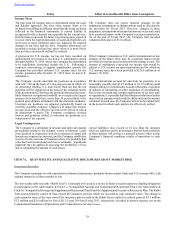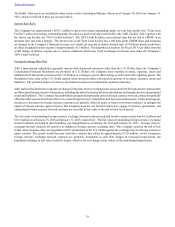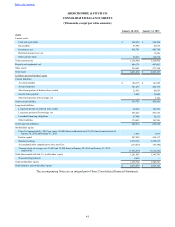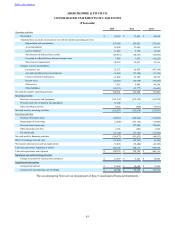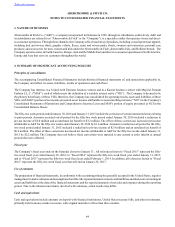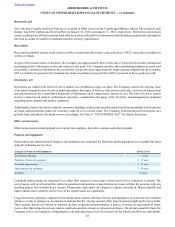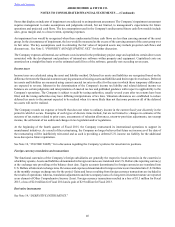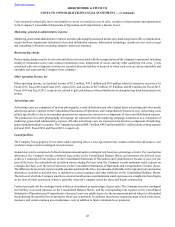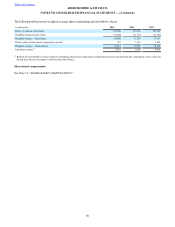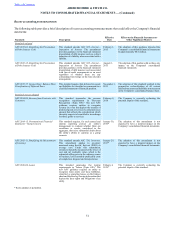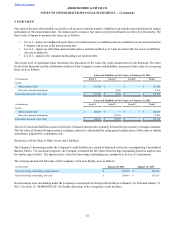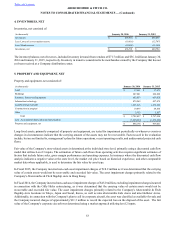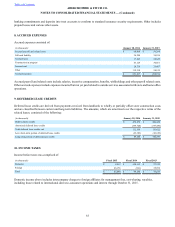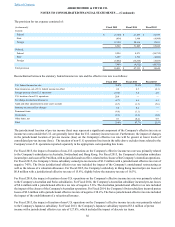Abercrombie & Fitch 2015 Annual Report Download - page 46
Download and view the complete annual report
Please find page 46 of the 2015 Abercrombie & Fitch annual report below. You can navigate through the pages in the report by either clicking on the pages listed below, or by using the keyword search tool below to find specific information within the annual report.
Table of Contents ABERCROMBIE & FITCH CO.
NOTES TO CONSOLIDATED FINANCIAL STATEMENTS — (Continued)
46
Stores that display an indicator of impairment are subjected to an impairment assessment. The Company’s impairment assessment
requires management to make assumptions and judgments related, but not limited, to management's expectations for future
operations and projected cash flows. The key assumptions used in the Company's undiscounted future cash flow models include
sales, gross margin and, to a lesser extent, operating expenses.
An impairment loss would be recognized when these undiscounted future cash flows are less than carrying amount of the asset
group. In the circumstance of impairment, the loss would be measured as the excess of the carrying amount of the asset group over
its fair value. The key assumptions used in estimating the fair value of impaired assets may include projected cash flows and
discount rate. See Note 5, “PROPERTY AND EQUIPMENT, NET,” for further discussion.
The Company expenses all internal-use software costs incurred in the preliminary project stage and capitalizes certain direct costs
associated with the development and purchase of internal-use software within property and equipment. Capitalized costs are
amortized on a straight-line basis over the estimated useful lives of the software, generally not exceeding seven years.
Income taxes
Income taxes are calculated using the asset and liability method. Deferred tax assets and liabilities are recognized based on the
difference between the financial statement carrying amounts of existing assets and liabilities and their respective tax bases. Deferred
tax assets and liabilities are measured using current enacted tax rates in effect for the years in which those temporary differences
are expected to reverse. Inherent in the determination of the Company's income tax liability and related deferred income tax
balances are certain judgments and interpretations of enacted tax law and published guidance with respect to applicability to the
Company's operations. The Company is subject to audit by taxing authorities, usually several years after tax returns have been
filed, and the taxing authorities may have differing interpretations of tax laws. Valuation allowances are established to reduce
deferred tax assets to the amount expected to be realized when it is more likely than not that some portion or all of the deferred
tax assets will not be realized.
The Company records tax expense or benefit that does not relate to ordinary income in the current fiscal year discretely in the
period in which it occurs. Examples of such types of discrete items include, but are not limited to: changes in estimates of the
outcome of tax matters related to prior years, assessments of valuation allowances, return-to-provision adjustments, tax-exempt
income, the settlement of tax audits and changes in tax legislation and/or regulations.
At the beginning of the fourth quarter of Fiscal 2015, the Company restructured its international operations to support its
omnichannel initiatives. As a result of the restructuring, the Company no longer believes that future net income as of the date of
the restructuring will be indefinitely reinvested and as such is providing a deferred U.S. income tax liability for the additional
taxes due upon a future repatriation.
See Note 10, “INCOME TAXES,” for a discussion regarding the Company’s policies for uncertain tax positions.
Foreign currency translation and transactions
The functional currencies of the Company’s foreign subsidiaries are generally the respective local currencies in the countries in
which they operate. Assets and liabilities denominated in foreign currencies are translated into U.S. Dollars (the reporting currency)
at the exchange rate prevailing at the balance sheet date. Equity accounts denominated in foreign currencies are translated into
U.S. Dollars at historical exchange rates. Revenues and expenses denominated in foreign currencies are translated into U.S. Dollars
at the monthly average exchange rate for the period. Gains and losses resulting from foreign currency transactions are included in
the results of operations; whereas, translation adjustments and inter-company loans of a long-term investment nature are reported
as an element of Other Comprehensive Income (Loss). Foreign currency transactions resulted in a loss of $1.5 million for Fiscal
2015, a loss of $2.0 million for Fiscal 2014 and a gain of $2.9 million for Fiscal 2013.
Derivative instruments
See Note 14, “DERIVATIVE INSTRUMENTS.”




